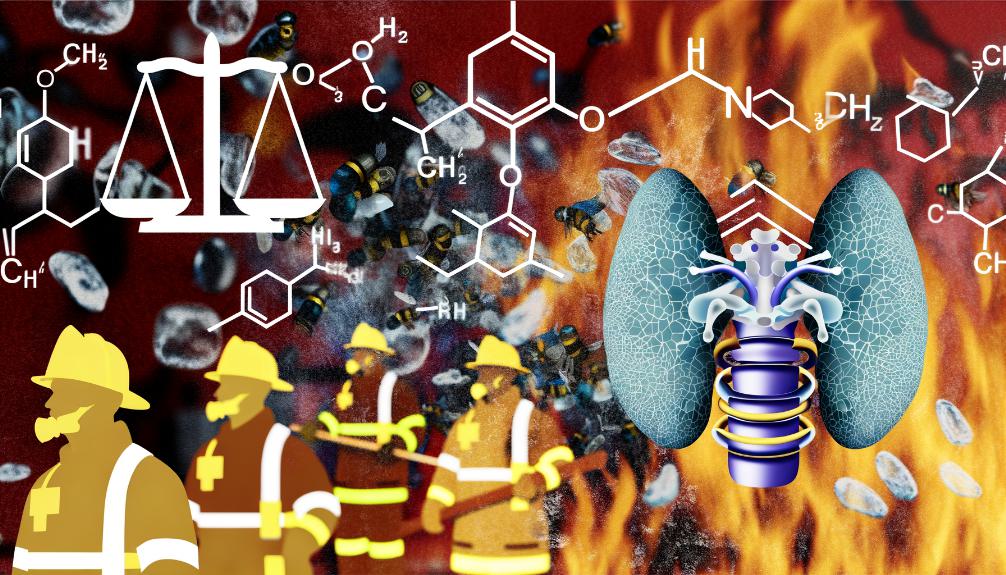Hypothyroidism Risk Factors in AFFF Litigation
We're monitoring the expanding legal battle concerning AFFF exposure and its connection to hypothyroidism. PFAS, found in AFFF, disrupts thyroid hormone systems, greatly raising hypothyroidism risk. In particular, female firefighters and military personnel are among the high-risk groups. Legal claims argue manufacturers negligently failed to warn about these hormone-disrupting chemicals. Compensation, depending on medical documentation and exposure duration, is a crucial aspect for victims. As litigation progresses, utilizing expert testimonies and scientific evidence becomes pivotal. The journey towards securing justice and thorough compensation highlights the importance of acknowledging these risk factors. For those affected, understanding the extent of this issue is key to exploring their legal options.

Key Takeaways
- AFFF exposure significantly increases the risk of developing hypothyroidism.
- Female firefighters and military personnel are particularly high-risk groups for hypothyroidism due to AFFF exposure.
- The duration of PFAS exposure impacts the severity of hypothyroidism and legitimacy of legal claims.
- Detailed medical documentation is crucial in establishing a link between AFFF exposure and hypothyroidism in litigation.
- Victims' compensation correlates with the severity of hypothyroidism and the extent of PFAS exposure.
PFAS and Thyroid Disruption

PFAS's interference with the body's thyroid hormone system notably increases the risk of thyroid dysfunction, especially in those exposed to AFFF. As we investigate further into this issue, it's apparent that PFAS act as potent endocrine disruptors. These chemicals have a profound impact on the enzyme activity essential for thyroid hormone synthesis. It's not just a vital disruption; PFAS accumulation in thyroid cells can greatly inhibit this critical enzyme activity, leading to a cascade of effects on thyroid function.
Research has consistently shown that different categories of PFAS have varying impacts on thyroid hormone balance and regulation. This variability underscores the complexity of PFAS's role as endocrine disruptors and their ability to contribute to thyroid dysfunction. What's particularly concerning is the link between PFAS exposure and hypothyroidism, along with abnormal thyroid hormone levels. These findings aren't just numbers on a page; they represent real-life implications for individuals, particularly firefighters, who are exposed to AFFF.
Understanding the mechanisms at play—how PFAS disrupt thyroid hormone synthesis and the enzyme activity within thyroid cells—is critical. This disruption doesn't just alter thyroid function in a vacuum; it has wide-reaching implications for overall health, given the thyroid's role in regulating metabolism, heart rate, and more. Our focus on PFAS exposure, especially through AFFF, sheds light on the urgent need to address these endocrine disruptors. The risks they pose to thyroid health can't be overstated, making it a critical area of concern for those impacted and for our broader public health discourse.
High-Risk Groups Identified
Identifying high-risk groups, such as female firefighters and military personnel regularly using AFFF, is essential in tackling the heightened threat of hypothyroidism they face. These individuals, because of their occupations, are more frequently exposed to Aqueous Film Forming Foam (AFFF), which contains per- and polyfluoroalkyl substances (PFAS). PFAS are notorious for their association with thyroid disease, including hypothyroidism, due to their disruptive effects on the endocrine system.
Female firefighters, in particular, have been highlighted as facing an increased risk. Their exposure to AFFF, which is often used in firefighting for its effectiveness in extinguishing fuel fires, leads to higher levels of PFAS in their bodies. This exposure, in turn, significantly escalates their risk of developing hypothyroidism. Similarly, military personnel, who are also regularly engaged in activities requiring the use of AFFF, face elevated risks of thyroid disease. Their prolonged exposure to PFAS through AFFF usage puts them squarely in the category of high-risk groups for developing thyroid disorders, including hypothyroidism.
The correlation between AFFF exposure and the development of hypothyroidism in these occupational groups has been substantiated by numerous studies. These findings underscore the importance of thorough monitoring and health assessments for firefighters exposed to AFFF. The health impacts of PFAS exposure, particularly in relation to thyroid disease, demand attention and action to mitigate the elevated risks faced by these high-risk groups.
Legal Grounds Explored

We're delving into the legal landscape, where the battle against manufacturers for negligence in the production and distribution of AFFF containing harmful PFAS chemicals is intensifying. Legal grounds for hypothyroidism claims in AFFF litigation hinge on demonstrating the manufacturers' disregard for the health risks posed by these toxic substances. The essential task is establishing a direct link between AFFF exposure and the onset of thyroid diseases, specifically hypothyroidism, a condition where the thyroid gland doesn't produce enough hormone.
In the courtroom, expert testimonies and scientific evidence are pivotal in substantiating claims that thyroid diseases linked to AFFF exposure were foreseeable and preventable. The legal argument extends to accusing manufacturers of failing to issue thorough warnings about the risk of chemicals known to disrupt hormone balance. This negligence has placed various groups, including military personnel, at an undue risk of developing hypothyroidism due to AFFF exposure.
To navigate these legal waters, claimants must compile detailed evidence, including thorough medical records that trace hypothyroidism back to AFFF exposure and expert opinions that reinforce the causal connection. This meticulous process aims to not only secure compensation for the affected parties but also to hold manufacturers accountable for their role in this public health issue.
The pursuit of justice in these cases underscores the importance of understanding the legal, medical, and military dimensions of AFFF litigation. It's about ensuring those harmed by negligent practices receive the compensation they're due, while also spotlighting the need for stringent regulations on harmful chemicals.
Health Implications Examined
As we explore further into the health implications of AFFF exposure, it's important to acknowledge that hypothyroidism, a significant consequence, drastically impacts the lives of those exposed. This thyroid disorder, stemming from interference in hormone synthesis by PFAS chemicals, underscores the critical nature of understanding AFFF's health consequences in litigation.
Hypothyroidism is not just a medical term but a life-altering condition. Scientific studies have solidified the link between PFAS exposure from AFFF and the onset of this thyroid dysfunction. For firefighters and others frequently encountering AFFF, this connection spells out a heightened risk, pushing the boundaries of occupational hazards into personal health crises.
The role of PFAS chemicals in disrupting the delicate balance of hormone production cannot be overstated. These substances, inherent in AFFF, are notorious for their persistence in the environment and the human body, leading to prolonged health implications. The litigation surrounding AFFF exposure is not just a matter of legal debate but a crucial fight for acknowledging and addressing the severe health repercussions faced by exposed individuals.
In light of these findings, it's clear that the stakes of AFFF litigation extend far beyond the courtroom. Understanding the profound impact of hypothyroidism and its tie to AFFF exposure is essential, not only for those directly affected but also in shaping future regulations and protections against PFAS chemicals. As we investigate the complexities of these cases, the health of firefighters and other exposed individuals remains paramount, guiding the pursuit of justice in AFFF litigation.
Compensation and Damages

Victims stepping forward in AFFF litigation can anticipate compensation for the life-altering condition of hypothyroidism, with settlements potentially ranging between $300,000 to $450,000. This compensation is vital in addressing the multifaceted repercussions of the disease, guaranteeing that victims receive the support they need. As we explore further into the nuances of these settlement negotiations set to commence in 2024, it's evident that the journey to fair compensation is paved with several key factors.
The quality of medical documentation, legal representation, duration of PFAS exposure, and the extent of victims' suffering are pivotal in determining settlement amounts. It's essential for victims to secure skilled legal representation proficient in the complexities of AFFF litigation. Our collective experience underscores the importance of thorough documentation of exposure history. This preparation is not just procedural but a fundamental step towards securing justice and fair compensation for the harm inflicted.
As we prepare for the upcoming settlement negotiations, we're reminded of the critical role of detailed medical documentation. This evidence is essential in illustrating the direct link between AFFF exposure and hypothyroidism, thereby reinforcing the legitimacy of claims. Our collective goal is to ensure that each victim's suffering is duly recognized and compensated in alignment with the severity of their condition and the duration of their PFAS exposure.

This post has been generated by AI and was not reviewed by editors. This is Not legal advice. Please consult with an attorney.




